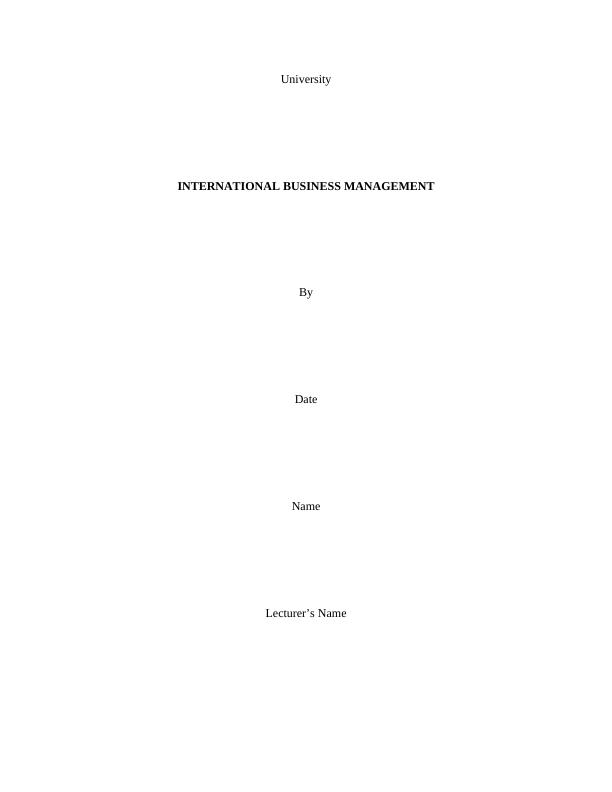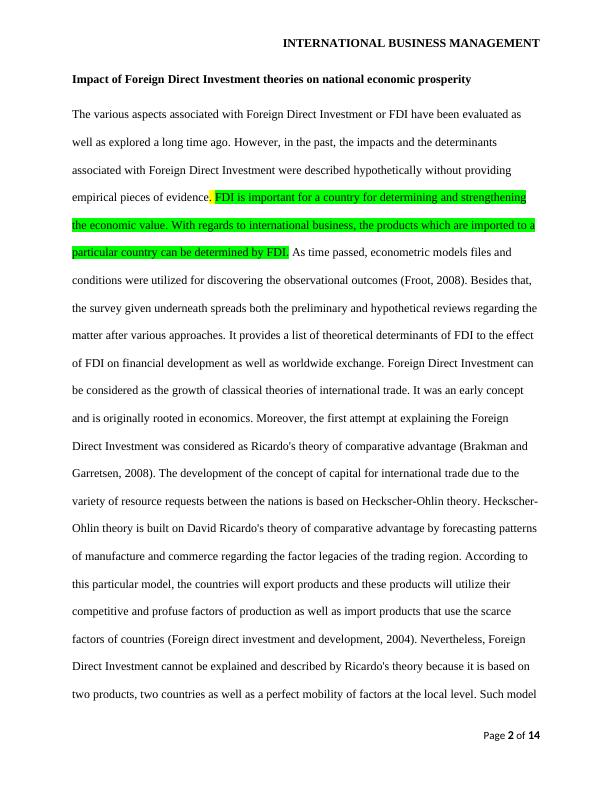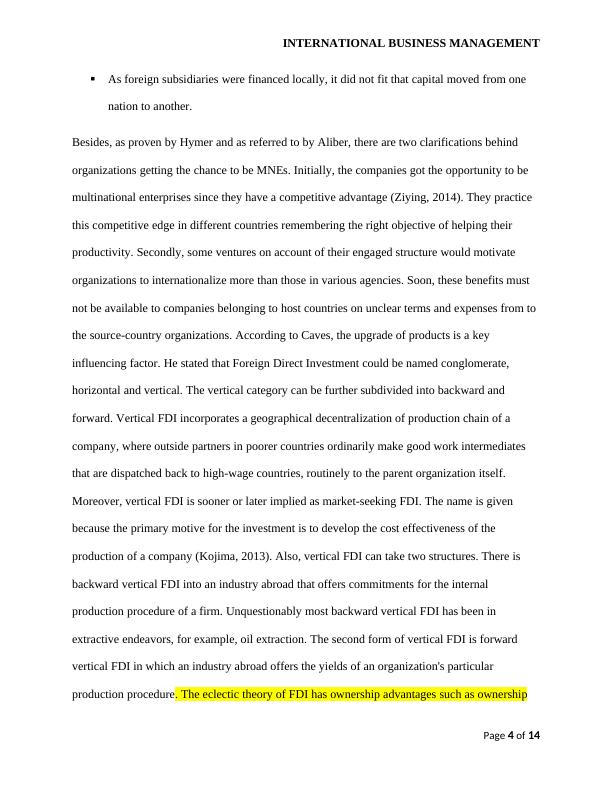Ask a question from expert
Impact of Foreign Direct Investment Theories on National Economic Prosperity
14 Pages4066 Words265 Views
Added on 2020-01-07
Impact of Foreign Direct Investment Theories on National Economic Prosperity
Added on 2020-01-07
BookmarkShareRelated Documents
UniversityINTERNATIONAL BUSINESS MANAGEMENTByDateNameLecturer’s Name

INTERNATIONAL BUSINESS MANAGEMENTImpact of Foreign Direct Investment theories on national economic prosperityThe various aspects associated with Foreign Direct Investment or FDI have been evaluated as well as explored a long time ago. However, in the past, the impacts and the determinants associated with Foreign Direct Investment were described hypothetically without providing empirical pieces of evidence. FDI is important for a country for determining and strengthening the economic value. With regards to international business, the products which are imported to a particular country can be determined by FDI. As time passed, econometric models files and conditions were utilized for discovering the observational outcomes (Froot, 2008). Besides that, the survey given underneath spreads both the preliminary and hypothetical reviews regarding thematter after various approaches. It provides a list of theoretical determinants of FDI to the effect of FDI on financial development as well as worldwide exchange. Foreign Direct Investment can be considered as the growth of classical theories of international trade. It was an early concept and is originally rooted in economics. Moreover, the first attempt at explaining the Foreign Direct Investment was considered as Ricardo's theory of comparative advantage (Brakman and Garretsen, 2008). The development of the concept of capital for international trade due to the variety of resource requests between the nations is based on Heckscher-Ohlin theory. Heckscher-Ohlin theory is built on David Ricardo's theory of comparative advantage by forecasting patternsof manufacture and commerce regarding the factor legacies of the trading region. According to this particular model, the countries will export products and these products will utilize their competitive and profuse factors of production as well as import products that use the scarce factors of countries (Foreign direct investment and development, 2004). Nevertheless, Foreign Direct Investment cannot be explained and described by Ricardo's theory because it is based on two products, two countries as well as a perfect mobility of factors at the local level. Such model Page 2 of 14

INTERNATIONAL BUSINESS MANAGEMENTcould not even allow FDI. During the year 1960, the microeconomic theory of international production was introduced. The method was proposed by Stephen Herbert Hymer. According to this theory, the reasons for internationalization of organizations are two kinds such as variables which are the outcomes of existence failures in market and variables connected to the ownership and dimension of an organization of particular advantage. FDI just happens when the benefits of abusing firm-particular points of interest (FSAs) crosswise over fringes authorizes defeating the extra expenses of working together abroad (Foreign Direct Investment, 2012). As per Hymer's thoughts, it has been contended that MNEs have firm-particular inclinations permitting them to work productively in separate nations. Heledd Straker has four disagreements. These disagreements were also distinguished by Hymer:Based on the old theory, it was suggested that the capital flow was one directional. One directional means unique way. It means that the capital flows from developed countries towards underdeveloped nations. However, in the real word after the war period, Foreign Direct Investment became two-way among the developed countries.The level of outward Foreign Direct Investment or FDI was found to vary between the industries. It means that if the capital availability was the driver of FDI, then there shouldbe no variation. The reason behind this is that all industries would be equally proficient and motivate to invest in international markets (Kalamova and Konrad, 2010).A country was supposed to involve either in external FDI or receive FDI only. In the meanwhile, Hymer found that Global Multinational Enterprises migrated in either direction across national boundaries in industries in industrialized nations. It means that those particular countries received inward and engaged in external Foreign Direct investment. Page 3 of 14

INTERNATIONAL BUSINESS MANAGEMENTAs foreign subsidiaries were financed locally, it did not fit that capital moved from one nation to another. Besides, as proven by Hymer and as referred to by Aliber, there are two clarifications behind organizations getting the chance to be MNEs. Initially, the companies got the opportunity to be multinational enterprises since they have a competitive advantage (Ziying, 2014). They practice this competitive edge in different countries remembering the right objective of helping their productivity. Secondly, some ventures on account of their engaged structure would motivate organizations to internationalize more than those in various agencies. Soon, these benefits must not be available to companies belonging to host countries on unclear terms and expenses from to the source-country organizations. According to Caves, the upgrade of products is a key influencing factor. He stated that Foreign Direct Investment could be named conglomerate, horizontal and vertical. The vertical category can be further subdivided into backward and forward. Vertical FDI incorporates a geographical decentralization of production chain of a company, where outside partners in poorer countries ordinarily make good work intermediates that are dispatched back to high-wage countries, routinely to the parent organization itself. Moreover, vertical FDI is sooner or later implied as market-seeking FDI. The name is given because the primary motive for the investment is to develop the cost effectiveness of the production of a company (Kojima, 2013). Also, vertical FDI can take two structures. There is backward vertical FDI into an industry abroad that offers commitments for the internal production procedure of a firm. Unquestionably most backward vertical FDI has been in extractive endeavors, for example, oil extraction. The second form of vertical FDI is forward vertical FDI in which an industry abroad offers the yields of an organization's particular production procedure. The eclectic theory of FDI has ownership advantages such as ownership Page 4 of 14

End of preview
Want to access all the pages? Upload your documents or become a member.
Related Documents
Assignment on Economic in UKlg...
|15
|2255
|45
International Businesslg...
|15
|3569
|155
Internationalisation of Business - Theories and Evaluationlg...
|7
|1412
|483
Internationalisation of business PDFlg...
|7
|1412
|33
Affirmative FTA with China Will Be Beneficial To Canada's National Welfarelg...
|3
|625
|441
International Trade and Investment Theorieslg...
|5
|693
|474